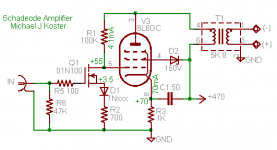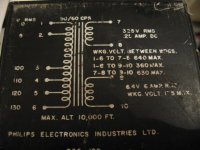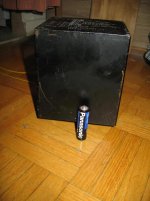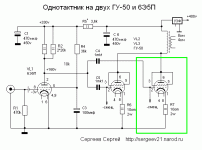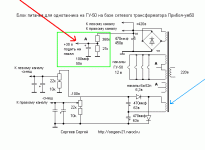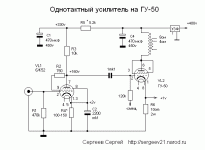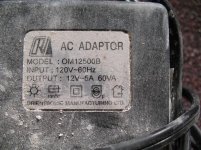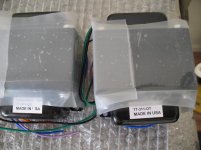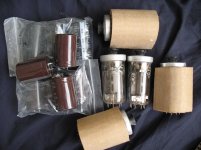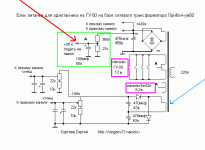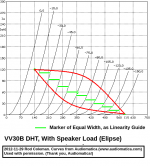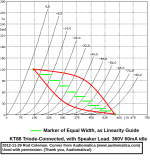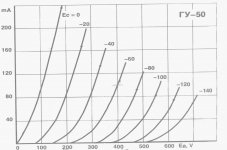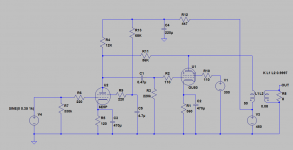quikie22 thanks for the circuit you posted but how Wavebourn wrote it is not correct so to me how is it useless. Sorry about that..
It is correct, except one resistor is drawn by mistake to be connected to the wrong point. Easy to correct.
Anyway before building an amp you will have to study it's schematic. Nobody can give you complete instructions, you have to understand some basics, otherwise may be electrocuted to death by high voltage.
Just An Idea
Garb
The following circuit is a suggestion, seeing that you have 6E5Ps and GU-50s. The variable resistor values given are a rough guide. Owing to the variability of the transconductance of the 6E5P it is difficult to give a specific value as one tube differs from another, just the nature of the high transconductance tube. The important point is to aim for 150V at the anode and screen.
Garb
The following circuit is a suggestion, seeing that you have 6E5Ps and GU-50s. The variable resistor values given are a rough guide. Owing to the variability of the transconductance of the 6E5P it is difficult to give a specific value as one tube differs from another, just the nature of the high transconductance tube. The important point is to aim for 150V at the anode and screen.
Attachments
It is correct, except one resistor is drawn by mistake to be connected to the wrong point. Easy to correct.
Anyway before building an amp you will have to study it's schematic. Nobody can give you complete instructions, you have to understand some basics, otherwise may be electrocuted to death by high voltage.
Hello Thank you The question it was only drawn wrong or it was build wrong to.. That was not cleared (or answered) from his side. The reason I wrote the circuit is not useful to me after I read your correction. I can build almost anything if is on the paper and correct (here I'm not talking using micro chips etc). I worked with power many years with electrician mostly residential and sometimes industrial also. That is not mean accident can't happen unfortunately many time happen even with experienced people to. Also I built amplifiers, fixed them, I did volunteer job in TV shop over 3 years. So I do not afraid from the power, I respect it but not afraid. Mostly built SS amplifiers and I did some (not much) tube work to so some help frome tube guys it would be great! Reason I asked for help, if the circuit correct I can build it! Now I have almost all the parts (all do today I studied the sergeev21 PSU circuit and I still need a transformer for the power tube bias. I'm not upset about him, not at all. I appreciate he wanted to help me all my respect to him..
Thanks Wavebourn
Greetings and Happy New Years
Apology
Gabor
Sorry I referred to you as Garb in the previous post. The amp I really like and have built is the Michael Koster Schadeode which is attached. Very simple. I am going to try a GU50 version in the near future. The front end mosfet also shows variability in its transconductance so you will have to adjust the source resistor to get 55V at the drain.
Gabor
Sorry I referred to you as Garb in the previous post. The amp I really like and have built is the Michael Koster Schadeode which is attached. Very simple. I am going to try a GU50 version in the near future. The front end mosfet also shows variability in its transconductance so you will have to adjust the source resistor to get 55V at the drain.
Attachments
Hello Thanks for the posted circuit! I do like them specially with the FET derived version. For now I decided I'll stick with these circuit, these amp was built and work correct how I get the info thorough translator... But.... I do have several question before I start to put together the amp to test it (& buy the missing parts like resisters etc). First I just realised I need one more transformer for the bias -V. If I'm right I need something around 60VAC?? What would be the min.VA req. for both channel? Second question There is something in the PSU circuit I do not understand manly because the language barrier, all do I learned some Russian when I was child in the school.. That little Russian knowledge already gone Well said if you don't used U loosed.. So I would like to ask for help where do I connect that +30 see red arrow green bracket..
Please someone help me with that! All do the circuit use two power tube I will go with one because my OPT only 10W. Do I have any disadvantage because I use only one GU50/ channel in these circuit. OK I get less power, that is still plenty to drive my speakers in a apartment.. I think these circuit can work perfect with one tube also but I ask some of you who has more experience with tube stuff in case I'll need some mode . I post a picture from my power transformer, I think is good quality some kind of Philips product. Good size and has the right the voltage I need. I do not have on the transformer the 12V for filament but I have separate transformer 12VAC 5A, or 12.5VDC 2.5A. So that would solve the problem.. I thought over and over what to do build the GU50 or go for the 300B. I decided if I already has everything almost at hand why would pas by with out give a try..
Thanks for any helps.
Greetings
Gabor
Please someone help me with that! All do the circuit use two power tube I will go with one because my OPT only 10W. Do I have any disadvantage because I use only one GU50/ channel in these circuit. OK I get less power, that is still plenty to drive my speakers in a apartment.. I think these circuit can work perfect with one tube also but I ask some of you who has more experience with tube stuff in case I'll need some mode . I post a picture from my power transformer, I think is good quality some kind of Philips product. Good size and has the right the voltage I need. I do not have on the transformer the 12V for filament but I have separate transformer 12VAC 5A, or 12.5VDC 2.5A. So that would solve the problem.. I thought over and over what to do build the GU50 or go for the 300B. I decided if I already has everything almost at hand why would pas by with out give a try..
Thanks for any helps.
Greetings
Gabor
Attachments
100V*( 100V/(10K+22K parallel 10K+22K) ) = 0.625VAIf I'm right I need something around 60VAC??
To the first tube heater.So I would like to ask for help where do I connect that +30 see red arrow green bracket..
Last edited:
Hello
Koszi szepen.= Thank you very much!
If I look at the tube data that can not be the first tube heater voltage.
http://www.shinjo.info/frank/sheets/113/6/6e5P.pdf
It must be 6.3V..
May be because there is the other circuit where he use 6Z52 tube. I will take a look.
http://www.shinjo.info/frank/sheets/112/6/6Z52P.pdf
Now I'm really confused because these tube heater req. 6.3V.
Do I misunderstanding something?
HAKAL is heater that sure, so you right but both tube data show me 6.3V.
Any way thank you very much.
I hope I get more help here..
I attach the other circuit where he use 6Z52.
I read in English 6E5P much better tube so I purchased that. I would live to use it.
Greetings Gabor
Koszi szepen.= Thank you very much!
If I look at the tube data that can not be the first tube heater voltage.
http://www.shinjo.info/frank/sheets/113/6/6e5P.pdf
It must be 6.3V..
May be because there is the other circuit where he use 6Z52 tube. I will take a look.
http://www.shinjo.info/frank/sheets/112/6/6Z52P.pdf
Now I'm really confused because these tube heater req. 6.3V.
Do I misunderstanding something?
HAKAL is heater that sure, so you right but both tube data show me 6.3V.
Any way thank you very much.
I hope I get more help here..
I attach the other circuit where he use 6Z52.
I read in English 6E5P much better tube so I purchased that. I would live to use it.
Greetings Gabor
Attachments
Some more parts
I thought I'll post more pictures from the parts I already collected.
So you can see I'm serious to build the amp.
I also have the tube sockets, 6E5P tubes, 12PC Epcos MKP 450V 150uF capacitors, each cost over $110 and other 450 470uF & 560uF.. I have more parts and more tubes just it is no reason to make picture from all.
I invested way to much just to gave up. I just need the resisters, and for the bias a transformer.
Of course those expensive caps was purchased for other tube project but I can use two piece here in case..
I hope someone will explain that +30V in the PSU circuit since I find the tubes req. 6E5P 6.3V & GU50 12V for filament. I do studied further the PSU circuit and now is 100% the filament voltage is the above mentioned.
I do mark the filament voltage, the designer clearly stated that in the circuit.
I hope soon I get some help and I can look for the rest of 5% the missing components.
Greetings Gabor
I thought I'll post more pictures from the parts I already collected.
So you can see I'm serious to build the amp.
I also have the tube sockets, 6E5P tubes, 12PC Epcos MKP 450V 150uF capacitors, each cost over $110 and other 450 470uF & 560uF.. I have more parts and more tubes just it is no reason to make picture from all.
I invested way to much just to gave up. I just need the resisters, and for the bias a transformer.
Of course those expensive caps was purchased for other tube project but I can use two piece here in case..
I hope someone will explain that +30V in the PSU circuit since I find the tubes req. 6E5P 6.3V & GU50 12V for filament. I do studied further the PSU circuit and now is 100% the filament voltage is the above mentioned.
I do mark the filament voltage, the designer clearly stated that in the circuit.
I hope soon I get some help and I can look for the rest of 5% the missing components.
Greetings Gabor
Attachments
Last edited:
Off Szia! On.It must be 6.3V..
I think +30V is the heater elevating voltage.
Some tube's overall noise is smaller with elevated heater.
Hello
Thank you
I'll wait until someone surly can confirm that.
Reading the tube data I can't go over 7V.
I will look after the GU50 tube to.
Today I read in Hungarian someone compared the GU50 with the 300B in the same amp with the min. necessary mode.
It can sound great, better than 6L6GT but not as good as the 300B. If it use good quality components in a good circuit can sound as good as a good KT88 almost like the 300B.
On the end of the the conclusion he made if we invest $$$$ on irons, parts to achieve good sound from the GU50 that $300-400 for a pair 300B tube not the end of the world.
So I think if I can resolve these question (I get some help) I do build the GU50..
elektroncso.hu - GU50 kontra 300B
Unfortunately is in Hungarian, but I'm still happy I found these information.
Greetings Gabor
Thank you
I'll wait until someone surly can confirm that.
Reading the tube data I can't go over 7V.
I will look after the GU50 tube to.
Today I read in Hungarian someone compared the GU50 with the 300B in the same amp with the min. necessary mode.
It can sound great, better than 6L6GT but not as good as the 300B. If it use good quality components in a good circuit can sound as good as a good KT88 almost like the 300B.
On the end of the the conclusion he made if we invest $$$$ on irons, parts to achieve good sound from the GU50 that $300-400 for a pair 300B tube not the end of the world.
So I think if I can resolve these question (I get some help) I do build the GU50..
elektroncso.hu - GU50 kontra 300B
Unfortunately is in Hungarian, but I'm still happy I found these information.
Greetings Gabor
This is the circuit that Wavebourn helped me with.
The plate load resistor for the 6E5P will be upgraded to gyrators once I get the time to do so.
Hello Quickie,
We're so lucky to have you pioneers.
It's been a couple of years now and am wondering if you've made any changes or advice on the GU50.
I'd like your latest schematic if possible.
I'm no techy but want a couple of stereo PP GU50 amps.
I hope your still about.
Thanks,
Is there really much difference between 300B and KT88 amp triode wired? Both 300b and KT88 have similar plate resistance. If anything the KT88 gives more power, KT88 cost heaps less.
Phil
Yes those are my thought too.
I am thinking of going with 4 gu50s per side PP for some bigger power.
I've read in some Japanese websites that PP 300B sounded better in there opinion.
One of the big parts and tube sellers says the GU50 is a much better tube than an EL34 or KT88 and is NOS.
I think this tube may be the new sleeper.
So you think,, start with a 300B design and make small adjustments, is that right?
Is there really much difference between 300B and KT88 amp triode wired? Both 300b and KT88 have similar plate resistance. If anything the KT88 gives more power, KT88 cost heaps less.
Phil
For non-critical amps, or amps where the budget does not allow for the B+ and filament supplies to be implemented properly (eg no choke-input for B+, or filament heating with ac or raw rectified dc) - then you may well be better with KT88, triode connected. The lower cost of the KT88 will be in line with the cost of the whole amplifier.
But if you take the trouble to implement a DHT 300B amp properly, you get open-loop linearity well above the triode-connected pentode class.
The curves below show why. With a speaker as a load, the reactive components force the "load-line" into an ellipse.
Comparing the two power valves, using Audiomatica's curves (used with their permission)
The Audiomatica Tube Directory
I have marked the curves with green markers of equal width, as a measure of linearity. In both cases, the operating point is 350V 60mA. The comparison is hopefully easy to make.
Attachments
My thoughts were to use the GU50.
This linearity could possibly help correct a problem in my system.
I have a woofer that has a very quick and pronounced rise in impedance before crossover point. 18db at 2000hz.
My 10" is fine crossed at 1800hz fourth order but it sounds so much nicer crossed at 2300hz, warmer and fuller, more chesty mid-range without the tweeter aggressiveness. The trouble is, it shouts a bit on loud vocal passages. Was thinking of using a zobel passively while crossing actively. There's many that say it won't help. I'm going to try it anyway.
Have you any comments on the GU50?
Thanks,
This linearity could possibly help correct a problem in my system.
I have a woofer that has a very quick and pronounced rise in impedance before crossover point. 18db at 2000hz.
My 10" is fine crossed at 1800hz fourth order but it sounds so much nicer crossed at 2300hz, warmer and fuller, more chesty mid-range without the tweeter aggressiveness. The trouble is, it shouts a bit on loud vocal passages. Was thinking of using a zobel passively while crossing actively. There's many that say it won't help. I'm going to try it anyway.
Have you any comments on the GU50?
Thanks,
Have you any comments on the GU50?
Thanks,
I think the ГУ-50 (GU-50) is a splendidly made power tube. But the linearity in triode will be similar to the triode-connected KT-88.
This is no surprise: most indirectly heated power tubes in triode produce curves like this (see below for ГУ-50 triode curves).
If you really like the ГУ-50, it may be better to design an amplifier that uses some kind of local feedback to improve its high-voltage linearity.
Since the OP question is a direct comparison in a SE amp, the 300B has the greater potential. But only if the B+ and filament supplies are implemented to a high standard.
Attachments
Hi Gabor
Did you make some decision which amp do you want ?
GU50 will be good start for tube amp because 300B project take forewer without experience. KT88 and 300B very different amps
Regards
I will build a 300B.
I read on a Hungarian site you can not bring out from the GU50 the type of sound even if it built with the best component than a medium built 300B.
To me that was enough to decide GU50 is not the amp I want.
Greetings
- Status
- This old topic is closed. If you want to reopen this topic, contact a moderator using the "Report Post" button.
- Home
- Amplifiers
- Tubes / Valves
- GU50 SE vs 300B SE tube amp??
